BOOK OF HOURSUse of Reims, illuminated manuscript in Latin [France, probably Reims, c. 1480] vellum, c.180×120mm, iii + 116 + iii leaves, sporadic pencil foliation in the lower right corners, lacking a calendar and one leaf with the start of the Hours of the Cross, probably with a miniature, else complete, collation: 1–78, 88-1 (last leaf missing; ff.57–63), 98, 102 (ff.72–73), 11–158, 164-1 (last leaf, blank, cancelled), written in gothic bookhand with 20 lines per page, the ruled space c.110×60mm, illuminated with three- and four-line foliate initials; one-, two-, and three-line initials in gold on a blue ground every page with at least a one-sided panel border of foliage, fruit, flowers, birds, etc. on a gold ground, or similar motifs on a ground divided into geometrical compartments with panels of stylised acanthus on grounds of solid colour, often with the initials NY joined by a love-knot, four small miniatures accompanied by three-sided borders, and fourteen large miniatures above three-line initials and four lines of text surrounded by full borders; sewn on five bands and bound in deep red 18th-century French morocco over pasteboards, the covers gilt with simple frame and corner ornaments, the spine densely gilt and with title ‘Breviariu[m]’ in capitals, marbled endpapers, gilt edges; somewhat scuffed, but unrestored, appealing, and sound TEXT The Gospel extracts (f.1); The Passion narrative based on the Gospel of John (f.6); prayers to the Virgin, starting with ‘O gloriosa domina’, ‘Obsecro te’, O intemerata’, ‘Santa Maria dei genitrix’, using masculine forms (f.14); Hours of the Virgin ‘selon lusage de leglise de Reins’ [sic] (f.27v); Hours of the Cross (f.64) and of the Spirit (f.67v); three added 15th-century prayers, the first in French, attributed to ‘saint Gregoire’, and carrying an indulgences of ‘xx mille ans & xxvi iours de vray pardon’ (f.71v); Penitential Psalms (f.74), followed by litany (f.85v) and collects, the litany including Sts Remi, Nivard, Réole, Macra, Bova, and Doda; Office of the Dead, Use of Reims (ff.90–116v). PROVENANCE (1) Doubtless written and illuminated at Reims, for a couple with the initials ‘N’ and ‘Y’ or ‘I’ (‘N’ and ‘I’ are on ff. 49v, 55v, on a lozenge and a shield respectively; perhaps Nicolas and Y/Isabeau?), which appear joined by a love-knot in many of the borders, and each of whose arms appear in five. One is azure, a chevron or between three eagles argent, beaked and clawed gules, two and one, in chief a crescent or (ff.1, 67), the first occurrence with helm, mantling, and a bird (woodpecker?) crest. This latter is close to the arms of the Brucheville and the Le Jolis de Villiers families, both of Normandy, and the Levasseur family of Le Mans. The other arms are azure, the lower part with four rows of downward-pointing argent triangles (ff.6, 35, 52v, and probably 49v, but overpainted): these do not appear to be normal armorial charges, and are perhaps the artist’s awkward attempt to depict vair (usually represented by interlocking argent and azure shapes similar to triangles). (2) Rebound in the 18th century, at which time the calendar was probably discarded; early flyleaf annotations include the number ‘373’. ILLUMINATION The style of illumination of both miniatures and borders is somewhat generic, and similar to manuscripts found from Paris and the Loire valley – suggesting that the general style was popular and widely emulated – but the peculiarities of the iconography suggest that it emanates from a rather individual local artist. The presence of the Tree of Jesse miniature is especially unusual, and suggests influence from early printed editions, in which the iconography was more common. The details of the compositions of the Annunciation to the Shepherds and the Presentation in the Temple are also very unusual. (The text is similarly idiosyncratic: between the groups of saints in the Litany for example, are the phrases ‘Sancte chorus apostolorum’, ‘Sancte chorus martyru
BOOK OF HOURSUse of Reims, illuminated manuscript in Latin [France, probably Reims, c. 1480] vellum, c.180×120mm, iii + 116 + iii leaves, sporadic pencil foliation in the lower right corners, lacking a calendar and one leaf with the start of the Hours of the Cross, probably with a miniature, else complete, collation: 1–78, 88-1 (last leaf missing; ff.57–63), 98, 102 (ff.72–73), 11–158, 164-1 (last leaf, blank, cancelled), written in gothic bookhand with 20 lines per page, the ruled space c.110×60mm, illuminated with three- and four-line foliate initials; one-, two-, and three-line initials in gold on a blue ground every page with at least a one-sided panel border of foliage, fruit, flowers, birds, etc. on a gold ground, or similar motifs on a ground divided into geometrical compartments with panels of stylised acanthus on grounds of solid colour, often with the initials NY joined by a love-knot, four small miniatures accompanied by three-sided borders, and fourteen large miniatures above three-line initials and four lines of text surrounded by full borders; sewn on five bands and bound in deep red 18th-century French morocco over pasteboards, the covers gilt with simple frame and corner ornaments, the spine densely gilt and with title ‘Breviariu[m]’ in capitals, marbled endpapers, gilt edges; somewhat scuffed, but unrestored, appealing, and sound TEXT The Gospel extracts (f.1); The Passion narrative based on the Gospel of John (f.6); prayers to the Virgin, starting with ‘O gloriosa domina’, ‘Obsecro te’, O intemerata’, ‘Santa Maria dei genitrix’, using masculine forms (f.14); Hours of the Virgin ‘selon lusage de leglise de Reins’ [sic] (f.27v); Hours of the Cross (f.64) and of the Spirit (f.67v); three added 15th-century prayers, the first in French, attributed to ‘saint Gregoire’, and carrying an indulgences of ‘xx mille ans & xxvi iours de vray pardon’ (f.71v); Penitential Psalms (f.74), followed by litany (f.85v) and collects, the litany including Sts Remi, Nivard, Réole, Macra, Bova, and Doda; Office of the Dead, Use of Reims (ff.90–116v). PROVENANCE (1) Doubtless written and illuminated at Reims, for a couple with the initials ‘N’ and ‘Y’ or ‘I’ (‘N’ and ‘I’ are on ff. 49v, 55v, on a lozenge and a shield respectively; perhaps Nicolas and Y/Isabeau?), which appear joined by a love-knot in many of the borders, and each of whose arms appear in five. One is azure, a chevron or between three eagles argent, beaked and clawed gules, two and one, in chief a crescent or (ff.1, 67), the first occurrence with helm, mantling, and a bird (woodpecker?) crest. This latter is close to the arms of the Brucheville and the Le Jolis de Villiers families, both of Normandy, and the Levasseur family of Le Mans. The other arms are azure, the lower part with four rows of downward-pointing argent triangles (ff.6, 35, 52v, and probably 49v, but overpainted): these do not appear to be normal armorial charges, and are perhaps the artist’s awkward attempt to depict vair (usually represented by interlocking argent and azure shapes similar to triangles). (2) Rebound in the 18th century, at which time the calendar was probably discarded; early flyleaf annotations include the number ‘373’. ILLUMINATION The style of illumination of both miniatures and borders is somewhat generic, and similar to manuscripts found from Paris and the Loire valley – suggesting that the general style was popular and widely emulated – but the peculiarities of the iconography suggest that it emanates from a rather individual local artist. The presence of the Tree of Jesse miniature is especially unusual, and suggests influence from early printed editions, in which the iconography was more common. The details of the compositions of the Annunciation to the Shepherds and the Presentation in the Temple are also very unusual. (The text is similarly idiosyncratic: between the groups of saints in the Litany for example, are the phrases ‘Sancte chorus apostolorum’, ‘Sancte chorus martyru
.jpg)
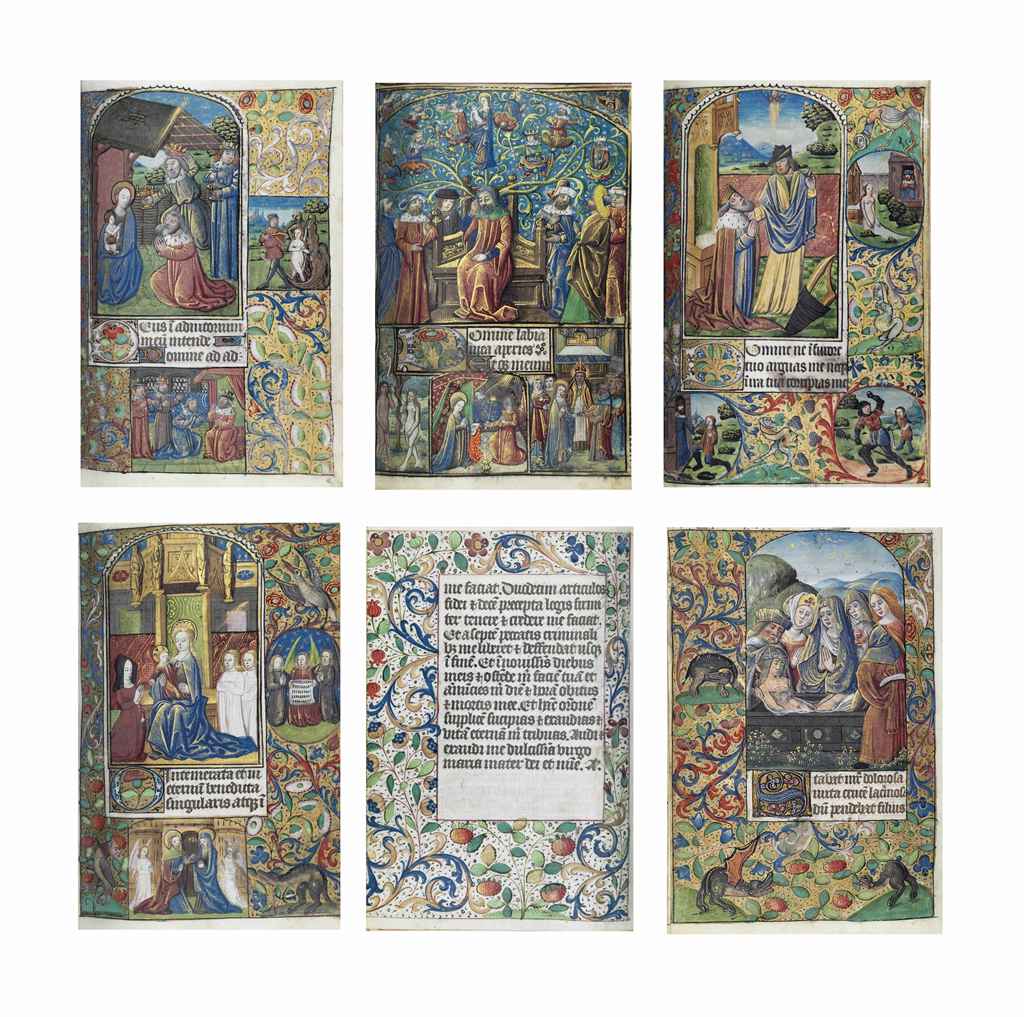
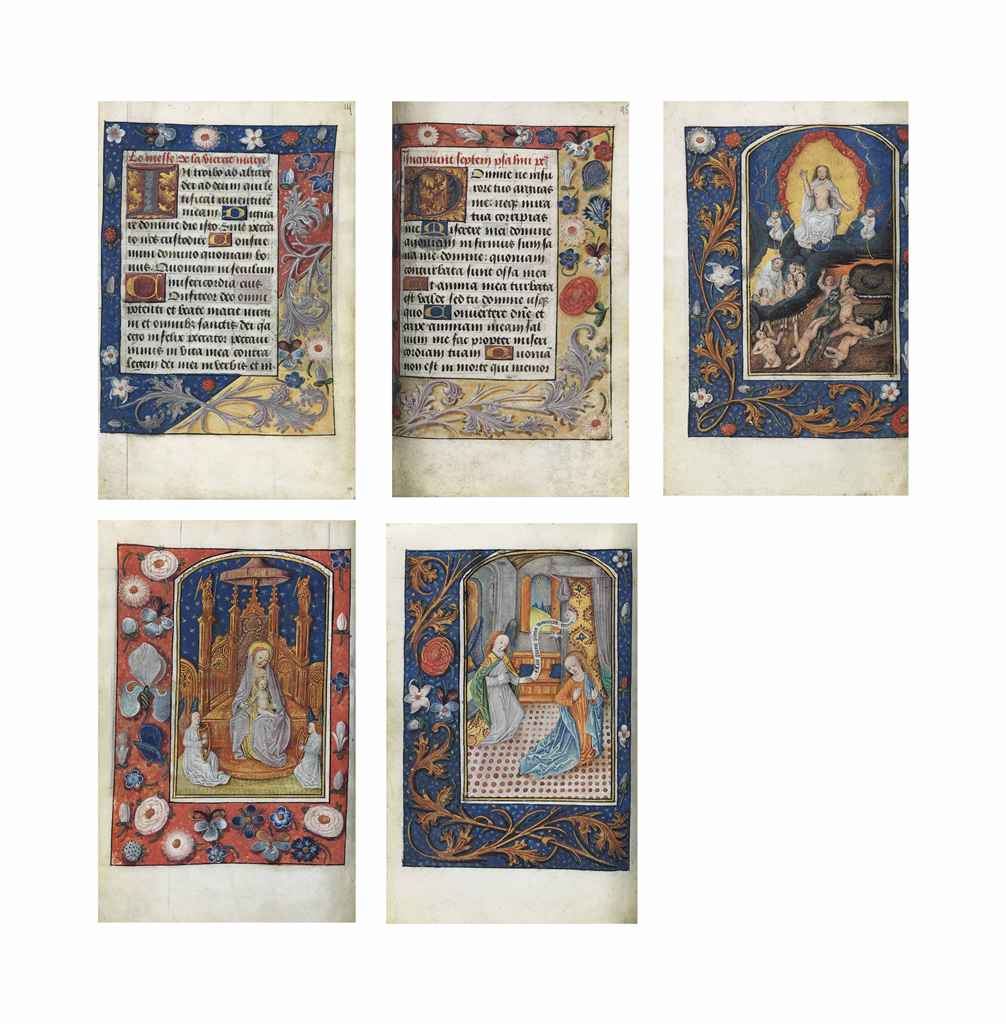
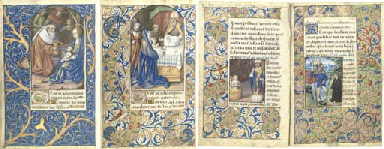
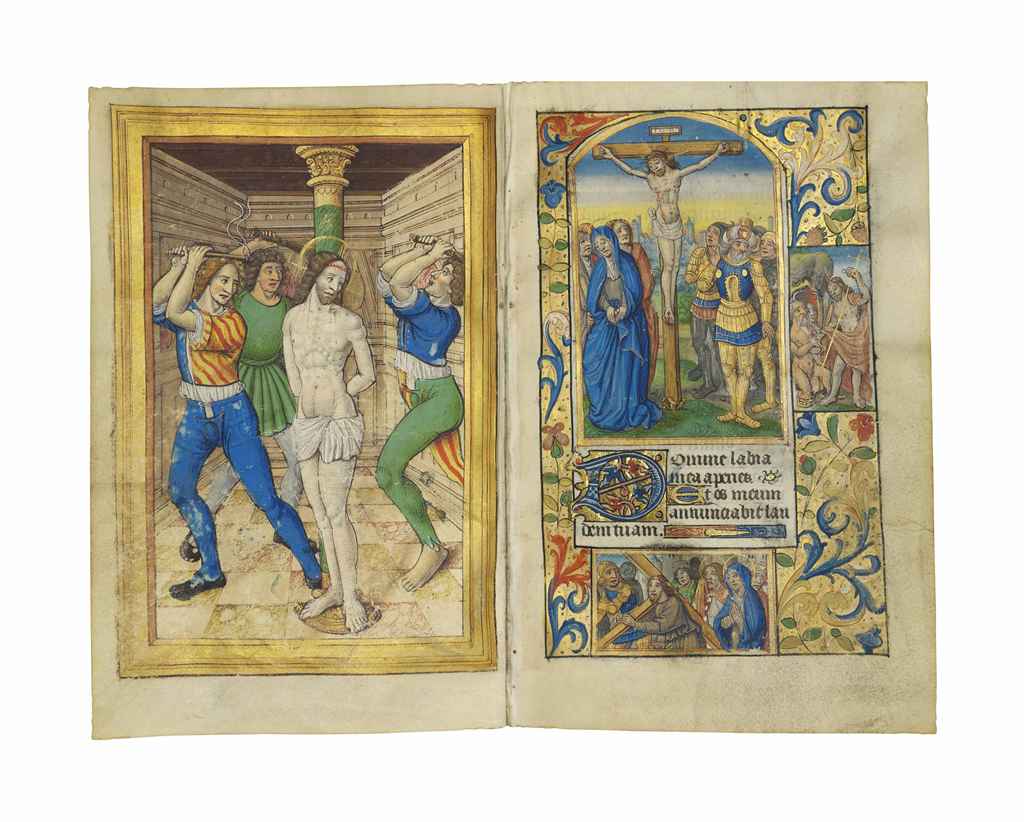
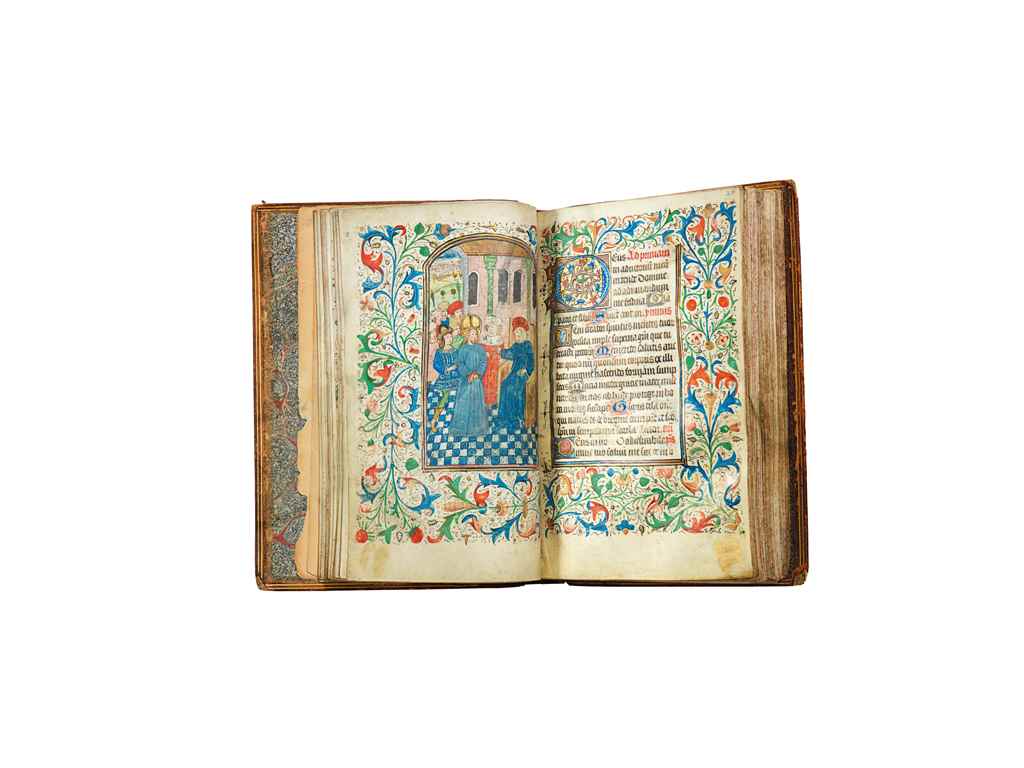


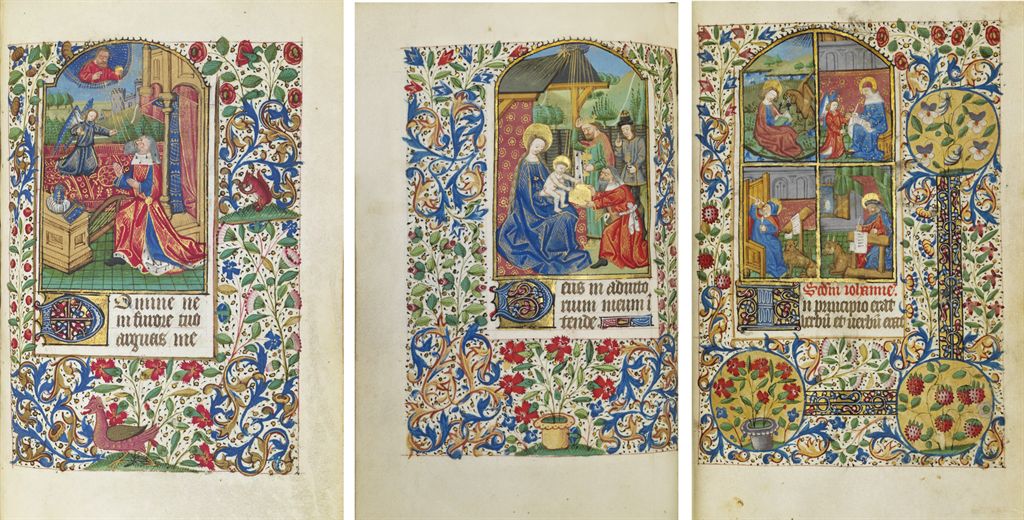
.jpg)


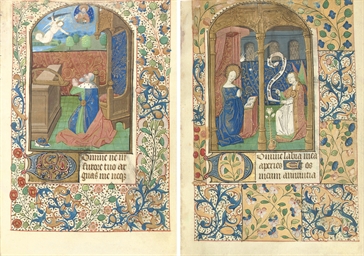
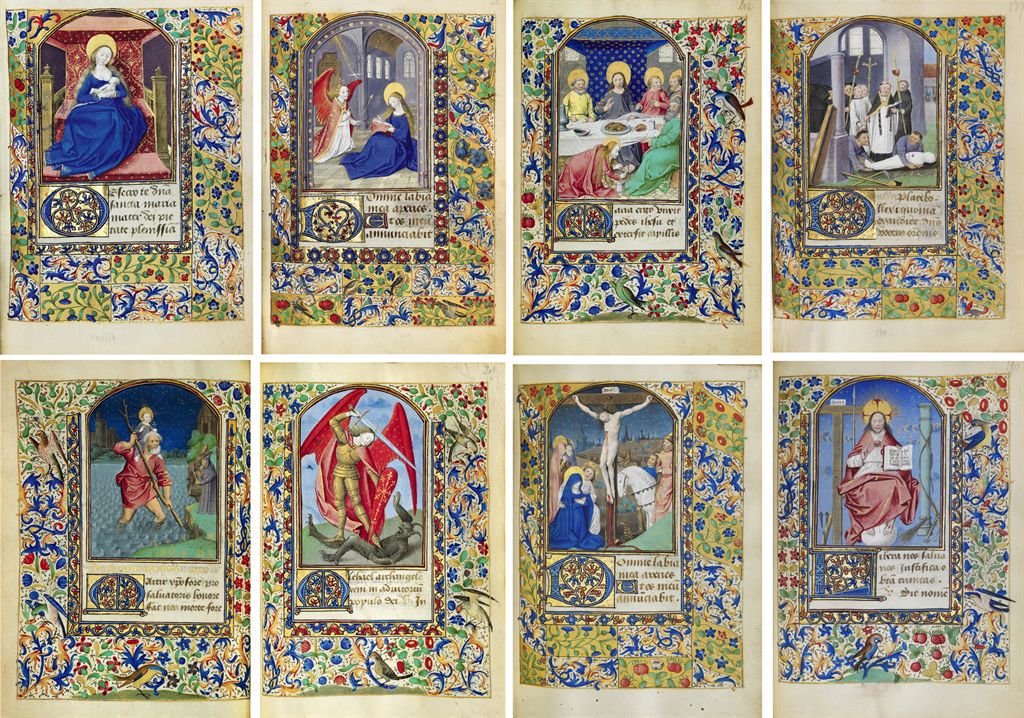
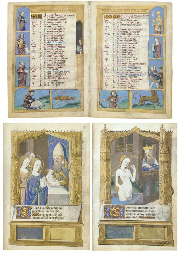
Testen Sie LotSearch und seine Premium-Features 7 Tage - ohne Kosten!
Lassen Sie sich automatisch über neue Objekte in kommenden Auktionen benachrichtigen.
Suchauftrag anlegen